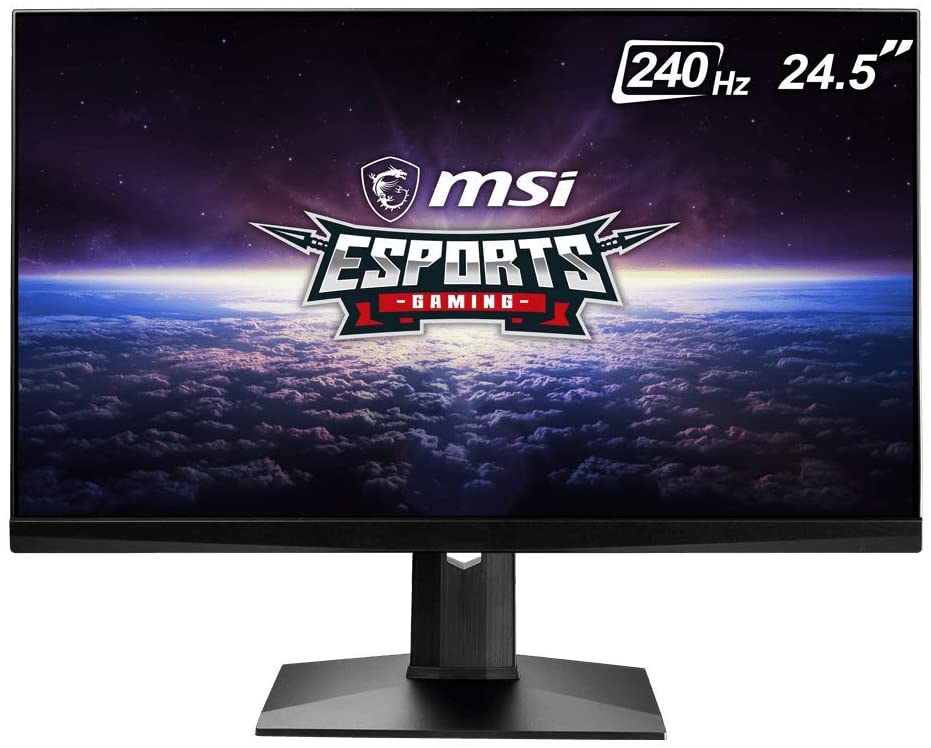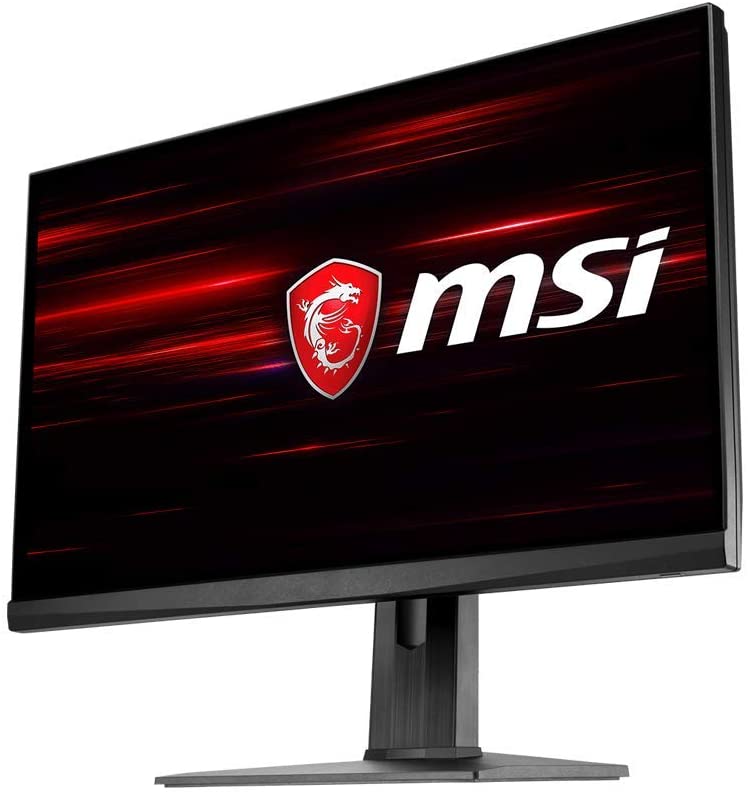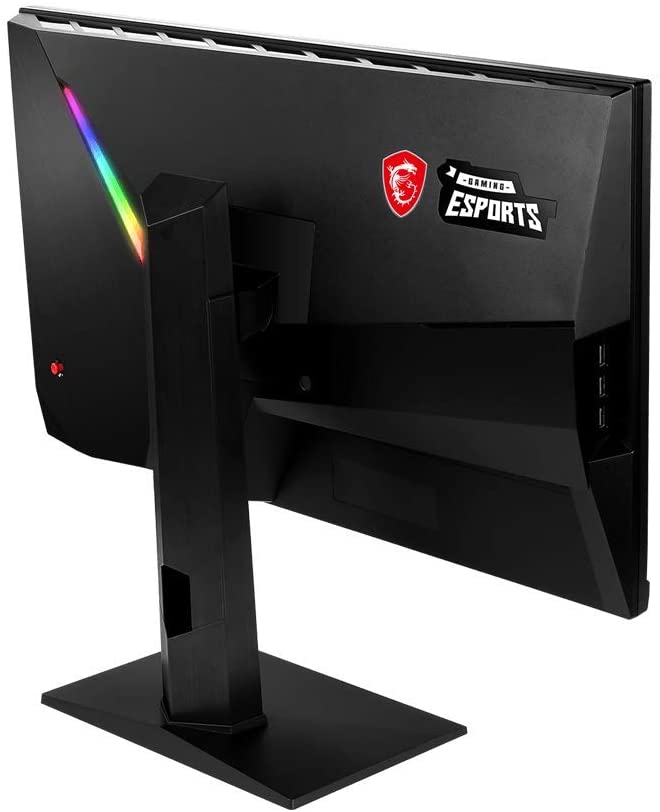
The MSI MAG251RX makes it easy to own a hyper-fast 240Hz monitor that offers the benefits of IPS technology wrapped into a great competitive gaming package. The 240Hz segment is very ruthless this year, especially when supply and demand do not meet due to the current global situation. Let’s see if the MSI MAG251RX is as competitive as its targeted audience when it comes to gaming and imaging performance.

MSI MAG251RX Specifications
- Screen Size: 25 Inches
- Resolution: 1920 x 1080 Full HD
- Aspect Ratio: 16:9
- Panel Technology: In-Plane Switching (IPS)
- Refresh Rate: 240Hz
- Response Time: 1ms
- Contrast Ratio: 1000:1 (Static)
- Brightness: 400 cd/m2
- Built-in Speakers: No
- Stand: Height – Yes
- Stand: Tilt – Yes
- Stand: Swivel – No
- Stand: Pivot – No
- VESA Compatibility: Yes
- Connectivity: DisplayPort 1.2 x 1, HDMI 2.0 x 2, USB 3.0 x 4, USB-C (15 Watts) x1, 3.5mm Jack x 1
- Dimensions with Stand(WxHxD): 19.93” x 19.96” x 7.18”
- Weight: 11.9 lbs

Design and Features
The MSI MAG251RX sports a simplified yet sophisticated design unlike most of its predecessors which were easily distinguishable. The device has a matte black chassis with a brushed texture at the rear that gives it a premium appeal. The display is bezel-free on three sides, but panel borders will still be visible when the monitor is in use.
The MSI MAG251RX is one of the smallest variants in its class, but of course, its display area isn’t affected. The device once fully assembled only needs 7.18 inches of depth which users with limited space will appreciate. The main cabinet is thicker than most, but that matters less unless you wall-mount your gaming monitors.
Build quality for the MSI MAG251RX is decent even if it feels less premium than its competitors with its seemingly thinner plastic panels. However, the device is quite durable and there are no unrefined edges or uneven seams on the product. The stand doesn’t wobble as well despite its modest proportions, so you can game as hard as you can with confidence.
There is also an RGB LED strip at the rear of the MSI MAG251RX, but its position and lighting output aren’t sufficient to produce a bias lighting effect. We always welcome decorative features since they add to the aesthetic value, but it should also be beneficial to important aspects. The LEDs can be set via the OSD or you can use MSI’s Mystic Light ecosystem so you can sync the monitor with the rest of your other MSI parts and peripherals.
We like that the MSI MAG251RX is already using a joystick instead of pesky OSD buttons to access its OSD. Many prospective users will most likely adjust some settings and features as needed, so a tool that makes that easier and faster is always handy. Its located at the back of the cabinet, but it isn’t difficult to reach since this model is still regular-sized by today’s standards.
The included stand with the MSI MAG251RX makes good use of the limited space it requires. However, it also only offers tilt and height adjustment for ergonomics which can limit your setup options. However, we think the mechanism’s vertical travel is more important, although you can use VESA mounts if necessary.
What makes the MSI MAG251RX special is its connectivity layout which includes a USB-C slot that supports DP Alt mode. You also get a DisplayPort 1.2 slot and two HDMI 2.0 ports which make the monitor very flexible for a number of host devices. One downside is the USB-C’s wattage output that is limited to 15 watts which isn’t enough for laptops like the MacBook Pro.
You will also find a USB hub at the side of the monitor that is easily accessible for your peripherals. Take note that you have to connect the monitor’s type-B port to your PC for data transfer to work.
The MSI MAG251RX doesn’t have speakers even if its chassis has the chunk to accommodate them discretely. We know its intended audience will mostly use headsets for better clarity, but built-ins are nice to have for the times where you just want to sit back or for conference calls in work from home setups.
Display and Performance
The MSI MAG251RX sports a 24.5-inch IPS panel with a 1920 x 1080 resolution, 240Hz refresh rate, and a 1ms boosted response time. The backlight goes up to 400 cd/m2 while the contrast ratio sits at a typical 1000:1 like most IPS panels. This model is also qualified for VESA’s DisplayHDR 400 standards, but we now know that its not powerful enough to produce compelling HDR improvements.
The MSI MAG251RX is perfectly sized for the native resolution since it isn’t pixelized or too sharp for any kind of use. Many GPUs will be able to produce high frames at 1080p, but you don’t get the extra space and crispness of 1440p or 4K variants. It is also comfortable to use for reading and office tasks since letters and numbers won’t appear microscopic without scaling.
The MSI MAG251RX covers 100% of the sRGB with some extensions which result in excellent vibrancy and saturation. Color accuracy at default sits at deltaE 2.08, so there is no need to immediately calibrate the display. The default color temperature is slightly cooler than the 6500K point, but it’s a welcome deviance since it makes white backgrounds look stark and bright.
Calibrating the display pushes the dE even lower to an average of only 0.64 which is already ideal for photo editing use. However, we don’t think it’s necessary unless you are going to use the monitor for photoshop or something similar. The MSI MAG251RX has an excellent price point and adding a colorimeter that will push your budget and enable you to go for a higher resolution model.
The MSI MAG251RX reaches as much as 1150:1 contrast at 45% brightness, although its black luminance is still limited when compared to VA types. The backlight reaches a searing 430 cd/m2, so we recommend turning it down as soon as you start using the monitor to get a more comfortable view. It is one of the few settings you need to tweak since the monitor already offers good image quality.
Panel uniformity for the MSI MAG251RX sample is excellent since there are no noticeable backlight leaks or clouding issues on any of the quadrants. There are some minor deviances in the spread of the backlight, but it is only noticeable when it’s measured with a colorimeter. Take note that this aspect varies between every unit due to the nature of IPS tech and some manufacturing tolerances.
The MSI MAG251RX is a very responsive monitor at both 144Hz and 240Hz, so blurring and ghosting won’t be an issue in fast-paced gaming. Setting the overdrive to faster for 144Hz and Fast for 240Hz cleans up the image output perfectly, so trails and pixel-sized artifacts won’t become noticeable. We recommend staying at these two levels for the two refresh rate settings since anything higher will induce overshoot.
The MSI MAG251RX is a FreeSync gaming monitor, but it also supports G-Sync via Nvidia’s G-Sync Compatibility Mode. This characteristic makes the monitor very practical since you don’t have to ditch it if in case you switch GPU brands. Input lag sits below 3ms, so there is no need to worry about delays while gaming.
Thoughts on the MSI MAG251RX
The MSI MAG251RX is a fantastic gaming monitor for the price thanks to its performance in imaging quality and gaming. The monitor is very fast and responsive, while its IPS screen offers vibrant colors and great accuracy right out of the box. It is also G-Sync and FreeSync compatible, so you get more value if you purchase this model.
We like how the MSI MAG251RX looks, but its feature set leaves some things to be desired such a better RGB implementation. However, these complaints are minor and mostly paid for by the inclusion of the USB-C port. We highly recommend buying this model if you want a high-performance gaming display that is also suitable for USB-C laptops and editing works.
Pros:
- Excellent Image Quality
- Great Factory Calibration
- Low Input Lag and Fast Pixel Response Time
- FreeSync/G-Sync Compatible
- USB-C
Cons:
- RGB’s Usefulness is Limited
- Stand Only Offers Tilt and Height Adjustments
About the Author:
Paolo is a gaming veteran since the golden days of Doom and Warcraft and has been building gaming systems for family, friends, and colleagues since his junior high years. High-performance monitors are one of his fixations and he believes that it’s every citizen’s right to enjoy one. He has gone through several pieces of hardware in pursuit of every bit of performance gain, much to the dismay of his wallet. He now works with Monitornerds to scrutinize the latest gear to create reviews that accentuate the seldom explained aspects of a PC monitor.


Leave a Reply